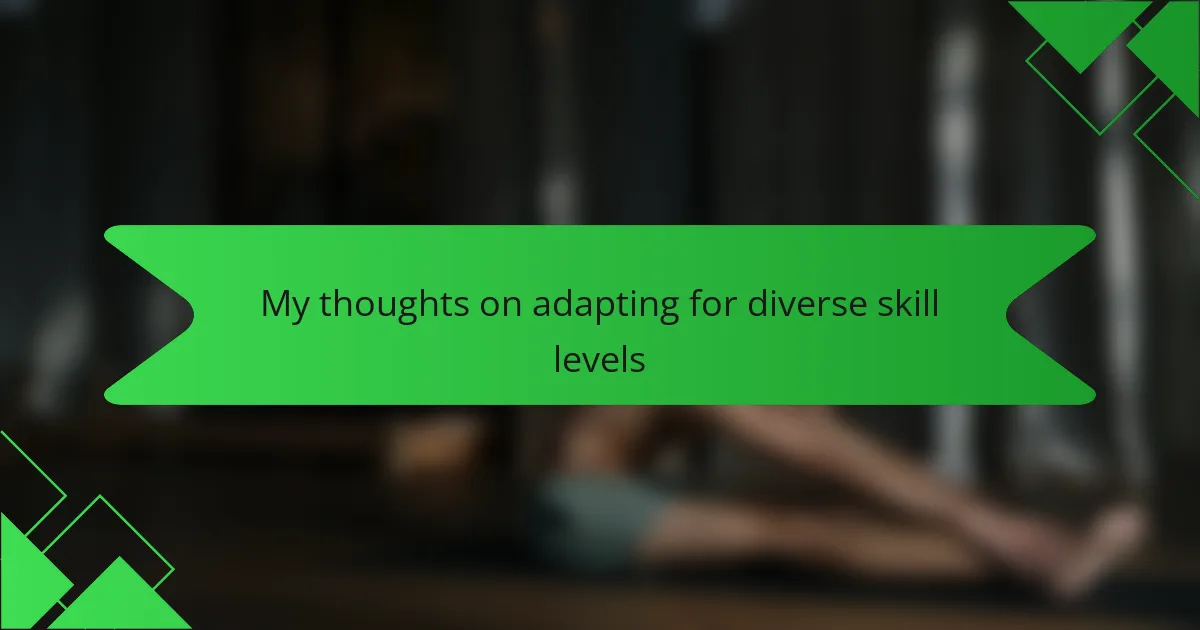Key takeaways
- Understanding skill levels in obstacle racing fosters a motivating environment and encourages participant engagement.
- Adapting courses and challenges for varying abilities enhances safety, confidence, and retention among racers.
- Effective assessment of individual capabilities leads to tailored training and prevents injuries, boosting morale.
- Scalable obstacle designs ensure inclusivity while maintaining excitement for all skill levels, promoting confidence and achievement.

Understanding skill levels in obstacle racing
Understanding skill levels in obstacle racing is crucial for creating a welcoming environment. From beginner to advanced, each level demands different physical abilities and confidence. I’ve seen firsthand how recognizing these distinctions helps racers stay motivated and enjoy the challenge without feeling overwhelmed.
| Skill Level | Key Characteristics |
|---|---|
| Beginner | Focus on basic endurance and form, learning obstacles, building confidence |
| Intermediate | Improved strength and technique, handling moderate obstacles, pacing strategy |
| Advanced | High strength and agility, complex obstacle mastery, competitive mindset |

Importance of adapting courses for diversity
Adapting obstacle courses for diverse skill levels is crucial to ensuring everyone can participate and enjoy the experience. From my own time coaching new racers, I’ve seen how adjusting challenges boosts confidence and keeps motivation high. It’s not just about safety; it’s about creating a welcoming environment where every participant feels capable and engaged.
| Aspect | Adapted Course | Standard Course |
|---|---|---|
| Skill Level Accommodation | Varied obstacles tailored to beginner, intermediate, and advanced abilities | Uniform obstacles that may overwhelm less experienced racers |
| Participant Experience | Positive, inclusive, encouraging progress and confidence | Competitive, possibly discouraging for novices |
| Safety | Reduced injury risk through modifications | Higher risk for unprepared participants |
| Retention | Higher due to enjoyable challenges suited to all | Lower as some may drop out due to difficulty |

Assessing individual capabilities effectively
Assessing individual capabilities effectively is crucial when preparing for obstacle course racing, especially with participants at different skill levels. From my experience, taking time to observe someone’s current fitness and technical skills versus jumping into intense training helps prevent injuries and builds confidence. I often see a boost in morale when people feel their strengths and limitations are genuinely understood.
| Assessment Method | Purpose |
|---|---|
| Physical Fitness Tests | Measure baseline strength, endurance, and agility |
| Skill Evaluations | Identify technical abilities like climbing or balance |
| Participant Self-Reporting | Understand individual comfort levels and goals |
| Observation During Practice | Spot areas needing tailored adjustments |

Designing scalable obstacle challenges
Creating obstacles that scale well for different skill levels is a real art. I remember designing a climbing wall where we added adjustable grips — beginners could use the larger, easier holds, while advanced racers tackled smaller, trickier ones. It made a huge difference in how confident each person felt approaching the challenge.
Have you ever watched someone’s face light up when they realize an obstacle isn’t out of reach? That’s the magic of scalable design. By layering difficulty within one challenge, we keep the course inviting without watering down the excitement for the more experienced racers.
From my experience, it takes thoughtful planning to balance safety and fun. Too easy, and racers get bored; too hard, and they get discouraged. Using modular elements lets me tweak obstacles on the fly, adapting to the mix of participants on race day, which keeps the energy high and everyone engaged.

Training tips for varied skill groups
Training tips for varied skill groups require a thoughtful balance between challenge and encouragement. From my experience, breaking down exercises into different difficulty levels helps keep everyone engaged, whether they’re just starting out or already crushing advanced obstacles. I’ve seen how small tweaks, like adjusting the height of a wall or offering modified grip options, make a huge difference in confidence and progress.
| Skill Level | Training Focus |
|---|---|
| Beginner | Basic movement skills, foundational strength, and confidence-building exercises |
| Intermediate | Technique refinement, endurance training, and moderate obstacle challenges |
| Advanced | High-intensity workouts, complex obstacle simulation, and power-endurance combination |

Personal experience with adaptive strategies
When I first started coaching obstacle racers, I quickly realized one size doesn’t fit all. I remember working with a group where one person struggled with basic balance while another was sprinting ahead on complex climbs. Adapting drills and obstacles on the spot made all the difference—we turned frustration into small wins, and those moments stick with me.
Have you ever felt the shift when a racer who initially doubted themselves suddenly nails a move after we adjusted the difficulty? That feeling of empowerment is why I believe adaptive strategies aren’t just practical—they’re transformative. It’s about more than skill; it’s about nurturing confidence and grit in every participant.
Looking back, some of my best memories come from tailoring challenges to fit individual needs. In one race, swapping out a high wall for a ramp helped a hesitant beginner finish strong, while the advanced racers took on the original climb. Seeing everyone cross the finish line, proud and smiling, showed me how vital adaptation truly is.
